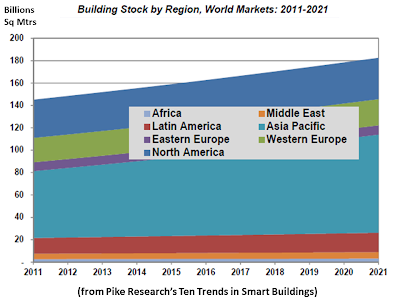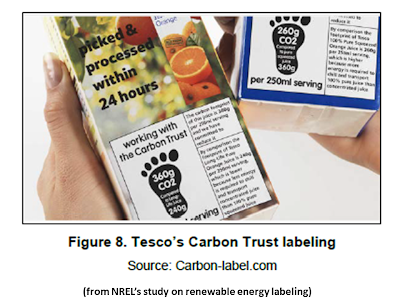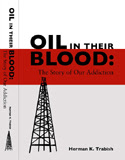TODAY’S STUDY: TEN TRENDS IN SMART BUILDINGS
Smart Buildings: Ten Trends to Watch in 2012 and Beyond
Eric Bloom and Bob Gohn, 2Q 2012 (Pike Research)
Executive Summary – A Snapshot of the Smart Building Industry Today
The smart building industry has been busy over the last few years. Advances in technology that make it easier to manage energy have considerably broadened the energy conversation, engaging not just facility managers, but also CEOs and CFOs. Although the effects of the global economic recession are still felt throughout the building and construction industries, technology vendors and integrators have continued to uncover new opportunities to improve energy efficiency in the existing building stock. The potential for energy efficiency has hardly been tapped even today.
Smart buildings employ a wide range of technologies that improve efficiency and connect buildings to each other as well as to the grid using intelligent, information and communication technology (ICT)-based devices and networks. Many of the technologies required for qualifying as a smart building, such as energy efficient heating, ventilation, and air conditioning (HVAC) systems and submeters, are mature. Others, such as building energy management systems (BEMSs) and building information modeling (BIM), are evolving rapidly and offer some of the most impactful innovations that the building industry has witnessed in years. The challenge that integrators face today, however, is tying these systems together in a way that maximizes profitability and leverages the strengths that each service provider in the smart building ecosystem brings to the table.
The one certainty is that demand for smart building technologies will continue to grow. The value proposition for many of these technologies has been demonstrated and a growing number of building owners are starting to adopt them with positive results. As the technology continues to evolve, improve, and decrease in cost, efficient and intelligent technologies will start to become an even more pervasive fixture in buildings worldwide.
Ten Trends in Smart Buildings
This white paper explores ten of the key trends that are transforming the smart building industry worldwide today, including:
• Building energy management hits the cloud
• Co-opetition is on the rise in the building industry
• Targeted acquisitions help key players deliver end-to-end monetized energy services
• Demand for smart building products in Asia Pacific will soar, driven largely by China
• U.S. energy service companies turn to the federal sector
• Building communication protocols are converging in more ways than one
• Demand response (DR) is shifting into automatic
• Submeters find new opportunities in smarter buildings
• Building information modeling is transforming the design process
• The interface between smart buildings and the smart grid is blurring
Ten Trends in Smart Buildings
Building Energy Management Hits the Cloud
The last year has catapulted building energy management into the 21st century. Since the dawn of building automation, buildings have been producing volumes of information, but few in the building industry started tuning in until the last few years. Today, a number of players are tapping into the big data that buildings are constantly producing and uploading it into the cloud as the basis for rich software-as-a-service (SaaS) offerings.
Virtually every leading name in the building services industry has made some kind of move on BEMSs that host and manage building data in the cloud recently. For example, in November 2011, Jones Lang LaSalle (JLL), the real estate industry giant, launched IntelliCommand, a service that builds on JLL’s usual business model – facility management and operations – by folding building energy data into other operational data and benchmarking it to identify areas of inefficiency and poor performance. This type of move can be seen in other commercial real estate firms, as well as with HVAC equipment vendors, including Schneider Electric and Siemens, as well as IT systems integrators, such as IBM and HP, and many others…
Co-opetition is on the Rise in the Building Industry
The building industry is highly fragmented. On the HVAC and equipment side, a handful of leaders, such as Schneider Electric and Johnson Controls, have large, multinational presences, but most of the market is divvied up among thousands of smaller companies, with a relatively narrow regional or technological focus. On the commercial real estate side, even CB Richard Ellis, the real estate firm with the largest footprint of space under management – 2.9 billion square feet (SF) – has captured less than 1% of the world’s 400 billion SF of commercial space.
These vendor-specific fiefdoms are starting to break down, as the demands of deep energy efficiency and energy management require considerable integration between disparate building systems. As demand for BEMSs, as well as comprehensive, end-to-end solutions for energy efficiency, including new capabilities like demand response and energy procurement, increases, the need for end-to-end services will push players to create alliances that plug gaps in service offerings and also to find ways to mutually reinforce one another, rather than compete against each other…
Targeted Acquisitions Help Key Players Deliver End-to-end Monetized Energy Services
When a nascent technology market reaches a certain point of maturity, smaller pure-plays start getting snapped up by larger established firms at breakneck pace. The smart building industry is starting to reach this point, as evidenced by a number of important acquisitions over the last year. Table 2.1 highlights several key acquisitions…
These are not examples of companies swallowing their peers to squelch competition. Rather, they are moves that indicate that the smart building industry is accelerating at such a pace that, when faced with the decision of whether to buy or to build, many of the major players are opting to buy, placing them on the map either geographically or technologically, rather than taking the time and investing in the resources to build new capabilities…
Demand for Smart Building Products in Asia Pacific Will Soar, Driven Largely by China
The figures surrounding the growth of the building industry in Asia Pacific are staggering. The region’s building stock represents over 40% of the world’s building space and is growing by over 2.4 billion square meters (m2) per year, most of which is in China. By 2025, China will build over 200 cities with a population of over 1 million, according to McKinsey & Company…
However, these huge numbers are not always reflected in the Asia Pacific region’s share of smart building technology today. Despite the region’s dynamic construction activity, it represents just 25% of the global market for BASs and controls, 20% of the global market for BEMSs, 17% of the global market for intelligent lighting controls, and a mere 6% of the global market for DR services. Despite the billions of square meters of new space that are added every year in the region, smart building technologies still have a proportionally low rate of penetration in new buildings in Asia Pacific…
U.S. Energy Service Companies Turn to the Federal Sector
Energy service companies (ESCOs), the core of energy efficiency activity in many building markets around the world, tend to stick with known client categories and rarely change direction. In Western Europe, ESCOs focus their business on the public and commercial building sectors. In China, they tend to focus on the commercial and industrial sectors. In the United States, nearly three-quarters of ESCO business focuses on the municipalities, universities, schools, and hospitals (MUSH) markets. The MUSH market has provided a consistent source of revenue over the last few decades and the level of familiarity with ESCOs and energy performance contracting is high among these clients.
Over the last few years, however, the federal sector has started to prove more inviting to ESCOs and energy performance contracting in the United States. Historically, the federal sector has represented a considerable portion of the U.S. ESCO industry – about 15% to 20% in a given year. Although the federal government has the foundations for strong ESCO support, including a number of federal mandates and targets for energy efficiency that have been put in place since 2005, adoption of the energy performance contracting model has not been uniform across all agencies. The inconsistent support for the ESCO model stems from a number of issues, such as a lack of familiarity with performance contracting among staff, the availability of direct Congressional appropriations for energy efficiency programs, and the availability of other avenues, such as purchases of renewable energy credits (RECs) to achieve federal agency emissions reduction targets…
Building Communication Protocols are Converging in More Ways than One
The word of the year in smart buildings is convergence. This concept broadly applies to the convergence of ICT with BMSs and other systems within buildings to create BEMSs that feed BMS-related data into centralized servers and software applications. Without a common IT network for building systems, coordinating all of a building’s systems in a way that optimizes energy efficiency and performance is difficult, if not impossible. ICT-enabled building devices – including the traditional networked devices, such as thermostats, sensors, and controls, as well as, increasingly, HVAC equipment and lighting fixtures themselves – are becoming ubiquitous, leading to a complete landscape of smart devices that can be integrated into a single system.
Communication protocols are the thread that holds the entire system together and a different type of convergence is taking hold of the communication world. Today, dozens of open (e.g., BACnet, LonWorks) and proprietary (e.g., Johnson Controls/Metasys) protocols exist, through which systems communicate with each other within a building or campus. Some devices with a proprietary protocol can communicate with others with an aftermarket translation device, but some systems simply cannot be integrated harmoniously into single networks…
Demand Response Is Shifting into Automatic
The average peak load is increasing every year. Last July, peak load in several grid operators’ domains broke their historic records. Extremely hot summers and cold winter days are partly to blame, but the growing population and the increasingly energy-intensive lifestyles of building occupants have also contributed to the increase. In response, many utilities and grid operators have turned to DR programs as a way to incentivize customers to reduce their non-essential energy demand.
DR, however, remains a largely manual process. Once an agreement has been reached between utilities, customers, and, in some cases, curtailment service providers (CSPs) like EnerNOC, DR resources are only dispatched after a facility manager at the customer site receives a signal from the utility or CSP. The manual process for dispatching DR often allows a grace period of 30 minutes or longer and many utilities could benefit significantly from faster response tmes…
Submeters Find New Opportunities in Smarter Buildings
Submeters – or metering devices – that building owners install to log utilities like electricity, gas, and water are by no means a new technology. Technologically similar to utility meters, which mediate the utility-customer relationship as opposed to the interface between building owners and tenants or individual building components, submeters have historically focused on two main applications. The first is basic tenant billing/cost allocation, in which submeters measure the energy consumption of individual building tenants, pieces of equipment, or individual buildings within a larger campus, filling in where utility meters leave off. The second is deep energy and power quality monitoring that tracks a wider range of concerns, such as current and voltage, particularly in commercial and industrial facilities. A handful of vendors have sold submeters over the years and installations have largely been ad hoc and based on a specific niche need at a given time. However, the recent push toward energy management in buildings is breathing new life into this mature technology. The mantra, “You can’t manage what you don’t measure,” is at the core of new thinking around energy in buildings, and few technologies are better positioned to measure and report energy consumption at a tenant or end-use level than submeters. An effective submeter system is like having an army of energy auditors with deep analytical capabilities taking building energy measurements every 15 minutes. That level of monitoring and control is of great appeal to business decision-makers. Although submeters by themselves do not reduce energy consumption, the information they provide can help building owners immediately detect poorly performing systems, and many submeter installations have been followed with energy cost savings of about 5% to 10% and short payback periods for the installation…
Building Information Modeling Is Transforming the Design Process
A smart building starts with a smart design. Many of the decisions that impact energy efficiency, such as the integration of HVAC, lighting, and other building systems, as well as basic considerations like orientation and materials, are made early in the design process and are difficult to change after the building’s initial design phases.
It is remarkable, therefore, that the design and construction process today remains highly fractious and poorly coordinated. Architects, engineers, and contractors operate largely independently of one another and optimize individual systems without using a whole systems approach to design. This can have catastrophic implications for green and energy-efficient buildings, as the standards required by LEED and increasingly stringent building codes raise the bar for energy performance…
The Interface between Smart Buildings and the Smart Grid Is Blurring
A broader view of the smart building industry reveals that much of the activity is happening less at the individual scale and more at the network level. BEMS tend to favor portfolios of buildings that can be controlled from a central location. In a sense, the intelligence that is finding its way into commercial and industrial buildings is creating a bird’s eye view of aggregations of buildings – and utilities are starting to pay attention.
For example, Pacific Gas & Electric (PG&E) is working with the energy management firm, C3, to deploy energy management software across PG&E’s commercial and industrial customer base to benchmark facilities and identify poorly performing ones. Utilities have long engaged customers on energy efficiency through demand-side management, but the pace and efficacy of such programs have received a considerable boost in recent years, as intelligent systems trickle into buildings. Around the world, moreover, grid operators are changing rules and providing market mechanisms that allow and incentivize DR, enabling demand-side resources (e.g., commercial buildings) to receive compensation for reducing their power demand during critical moments. Without sophisticated control systems, these types of programs would simply not be possible.
The interest that smart buildings have piqued among utilities has led some energy management firms to turn their gaze to utilities as customers as well. Vancouver-based Pulse Energy has shifted its strategy to utilities, providing energy management software that specifically aims to assist utilities in achieving energy efficiency targets and improving customer satisfaction with service. Others, such as Retroficiency and FirstFuel, have considerably expanded their energy management offerings for utilities as well. These moves suggest that, while the needs and priorities of utilities are far different from those of building owners, deploying a single system across an entire utility customer base makes more marketing sense than netting individual building owners as customers one by one.
The high-profile acquisitions and product announcements that smart building leaders have made in recent years also indicate that the building industry is looking increasingly upstream and is enhancing its interactions with the grid. Schneider Electric’s acquisition of leading smart grid firm Telvent, and Johnson Controls’ acquisition of DR firm EnergyConnect illustrate that building industry leaders are eager to tie buildings with the grid through an intelligent network. In January 2012, Echelon announced a new suite of products designed to make buildings grid-aware by integrating disparate BASs and enabling them to respond to real-time grid conditions. These are just a few of the many examples of how the building industry is taking a much more expansive view of the types of services they aim to offer building owners and managers to address the smart building market opportunity.
In the future, the definition of a smart building will continue to expand, as the technology evolves and as the regulatory and standards environment for DR and building automation matures. Together, smart buildings and the smart grid will continue to reinforce each other, providing continuing opportunities to improve energy efficiency, as well as the economics of operating the electricity grid.


 click to enlarge
click to enlarge click to enlarge
click to enlarge click to enlarge
click to enlarge click to enlarge
click to enlarge click to enlarge
click to enlarge click to enlarge
click to enlarge click to enlarge
click to enlarge click to enlarge
click to enlarge click to enlarge
click to enlarge click to enlarge
click to enlarge click to enlarge
click to enlarge click to enlarge
click to enlarge click to enlarge
click to enlarge click to enlarge
click to enlarge click to enlarge
click to enlarge click to enlarge
click to enlarge click to enlarge
click to enlarge click to enlarge
click to enlarge click to enlarge
click to enlarge click to enlarge
click to enlarge click to enlarge
click to enlarge click to enlarge
click to enlarge click to enlarge
click to enlarge click to enlarge
click to enlarge click to enlarge
click to enlarge click to enlarge
click to enlarge click to enlarge
click to enlarge click to enlarge
click to enlarge click to enlarge
click to enlarge click to enlarge
click to enlarge click to enlarge
click to enlarge click to enlarge
click to enlarge click to enlarge
click to enlarge click to enlarge
click to enlarge click to enlarge
click to enlarge click to enlarge
click to enlarge click to enlarge
click to enlarge
 Plug-in Hybrids, The Cars That Will Recharge America
Plug-in Hybrids, The Cars That Will Recharge America Oil On The Brain
Oil On The Brain